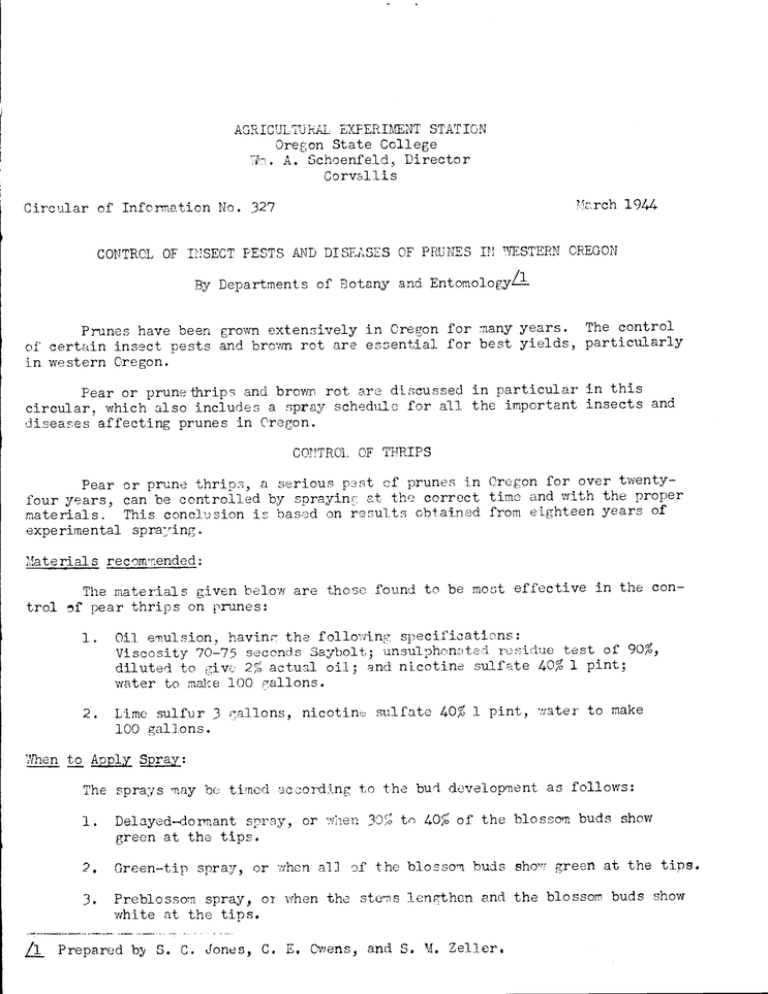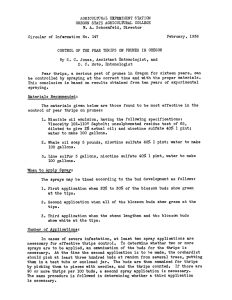AGRICTJLpdhJ.L EPEPINT STATION March 1944
advertisement

AGRICTJLpdhJ.L EPEPINT STATION Oregon State College in. A. Schoenfeid, Director Corvollis March 1944 Circular of Infonration No. 327 CONTROL OF' I1SECT PESTS AND D13E.SES OF PRUNES IN WhSTEEN OREGON By Departments of Botany and EntornologyLi Prunes have been grown extensively in Oregon for many years. The control of certain insect pests and brown rot are essential for best yields, particularly in western Oregon. Pear or prune thrips and brown rot ore discussed in particular in this circular, which also includes a spray schedule for all the important insects and diseases sifecting prunes in Oregon. CONTROl.. OF THRIPS Pear or prune thrips, a serious pest of prunes in Oregon for over twentyfour years, can be controlled by sprayine at the correct time and with the proper Thig conclusion is. based on results obtained from eighteen years of materials. experimental spraying. Materials recommended: trol The materials given below are those found to be most effective in the conf pear thrips on prunes: 1. 011 emulsion, havina the following specifications: Viscosity 70-75 seconds Saybolt; unsuiphonotad residue test of 90, diluted to give 2 actual oil; end nicotine sulfate 4O 1 pint; water to make 100 gallons. 2. Lime sulfur 3 gallons, nicotine sulfate 4O 100 gallons. 1 pint, water to make pply Spray: When to The sprays may be timed uccording to the bud development as follows: to 4O of the blossom 1. Delayed-donnant sproy, or when 3O green at the tips. 2. Green-tip spray, or when a1 3. Preblossom spray, or when the stems lenmthon and the white at the tips. LL Prepared b of the blossom buds show S. C. Jones, C. E, Owens, and S. M. Zel].er. buds show green at the tips. blossom buds show 2 Number of Anolications; In cases of severe infestation, at least two spray applications are necesTo determine whether two or more sprays are sary for effective thrips control. At the to be applied, an examination of the buds for the thrips is necessary. time the second application is to be made, the orchardist should pick at least three hundred buds at random from several trees, puttin them in a test tube or enclosed jar. The buds are then examined for thrips by picking them to pieces with If there are 90 or more thrips per 100 buds, a needles, and the thrips counted. The same procedure is followed in detersecond spray application is necessary. mmmc whether a third application is necessary. The schedule given above cannot always be followed precisely due to rains, It nay be necessary, win1s or other conditions which occur at the time outlined. therefore, to spray slightly hefore or after the time given in the schedule to take advantage of more favorable spraying conditions. The proposed schedule must be followed as closely as ossihILe, however, in order to obtain satisfactory control. Thog Spraying Necessary: Thrips are likely to be anywhere on the trees. Therefore, the spray should Th spray materials are contact sprays and must wet reach every part of the tree. The spray equipment shoud he capable of maintaining the insects to kill them. from 300 to 350 pounds pressure during the soraying operations. A coarse driving spray will force the spray into the buds better than a fine sproy and is recommended. Preparedness Essential: Spray materials should be on hand before the buds begin swelling in the Sprayers should be overhauled and put in good condition several weeks bespring. Success in thrips control may depend on a very few fore the spray season begins. days when spraying is possible. A delay for any reason may mean failure to control this pest. Caution: If oil, is used in the first spray, it should also be used in the later Ltme sulfur followed The same rule applies in the use of lime sulfur by oil or oil followed by line sulfur nay result in serious injury. sprays. COPTROL OF B1gYIN POT The severity of brown rot, a common disease of prunes, varies from year to year depending Upon climatic factors. During green fruit stages no significant amount of brown rot is apt to appear un.ess thre is considerable wet weather. As the fruit approaches the ripening period the danger from brown rot becomes greater, espectally if there is much wet weather or very high humidity. Thether prunes are to he dried, canned or shipped fresh, brown rot must be Prown rot originates in the held in check as the fruit aporoaches maturity. orchard but may spread disc strousy in 1us or' pacl-s after harvest if the fruit is held long in storage or in transit. This ic especially true in case of prunes shipped fresh to eastern markets. In a year favorable to brown rot development it may not be possible to avoid all rot by preventive measures but the followine program is suggested to reduce losses to a minimum. Sprar or Dust Program for Brown Rot Control: The best known materials These for the control of brown rot on prunes are sulfur spray or sulfur dusts. is use whichever he prefers or are abou.t equally effective and the grower may Dusting has finer. equipped to use. If dust is preferred use 325-mesh sulfur or of application, and several advantages over sprayin, such as ease and economy less objectionable appearance of residue on the fruit. I. As a spray for prunes ordinary sulfur with a commercial wetting agent is PR, and others most practical. Such commercial wetting agents as Vatsol, Nacconal casuln-tyne spreaders because of available through dealers,' are superior to the fact that these do not leave as conspicuthe waxiness of the prune fruit, and the Use 1/4 lb. of the wetting agent to 100 eus residues as the casein spreaders. eallon.s of spray. To prepare the spray, add the wetting agent to about 2 gallons of water; hen thoroughly mixed pour into spray tank and stir while sifting in the sulfur. fill to capacity. If the orchardist has wettable sulfur already on hand it may be used instead. of the ordinary sulfur with a wettjn agent as described above. The latter, however, is cheaper. Even some wettable sulfurs may need an extra wetting agent, unless the directions given by the manufacturer indicate that they have enough of a suitable wetting acent present. A trial on some prunes will indicate whether the spray wets sufficiently well. Time and Nirther of Applications will vary with weather conditions but A. the fol].owing recommendations will fit the average year. 1. Six pounds First Application: About five weeks before harvest. sulfur plus 1/4 pound wetting agent to 100 eallons; or dusting sulfur. 2. Later Applications: Repeat once a week, using same matrials as No. 1, giving last app1iction a few days before harvest. Other Precautions Recommended: In addition to a well-planned and II executed spray program there are certain other practices which should help materially in reducing the amount of brown rot in shipments of fresh prunes. 1. Exercise the greatest care in picking and handling to avoid stem punctures and any other fresh abrasions. Any break in the skin of the fruit enables brown rot to gain a foothold more easily. * Miller Products Co., 1932 SW. Water Avenue, Portland, Oregon. California Spray Chemical Co., 2127 N. Albina St., Portland, Oregon. Rogers, Portland, Oregon. Van Waters National Analine and Chemical Co., 730 Ph Burnside St., Portland, Oregon. Stauffer Chemical Co., North Portland, Oregon. fruit with any brown-rot spots in the 1us when 2. Avoid placing picking. 3. Dust thoroughly both the lugs and the packing boxes inside and outThe lugs should be dusted side with dusting sulfur before using. precaution is most important. each time they are used. This SPRAI PROGRAM FOR PRUNES Insect Time of application 1. As Dormant spray. winter buds are ready to open. 2. 3. Delayed-dormant spray. Tnen 30 to 40% of buds show green tips. San or disease Jose scale, twig miner Spray material and strength If scale is absent dilute 10 to Lime sulfur 12 to 100. 100. Lecaniuri scales and mite eggs, An oil emulsion to give 4 Thrips. Lime sulfur 3 gallons to 100 present delay spray 100 gallons of water, or 2% oil blossom applications. 1 pint, as described If no thrips are to ereen tip and pre- percent actual oil. and nicotine sulfate 1 pint to emulsion nicotine sulfate 40% on p. 2. Green-tip spray. iost of buds green Thrips. Same as 2. Preblossom spray. Buds white just before opening. Brown rot. Cultivate to destroy brown rot Bud moth Syneta beetle Twig miner Lead arsenate 1 at tip. 4. 5. First fruit dust. About spray or 5 weeks on ground. gallons. Aphids and Nicotine sulfate, 1 pint to Thrips 100 gallons, or same as 2 Lesf spot and brown Use wettable-sulfur spray, 6 pounds to 100 gallons, oi rot. plus spreader; sulfur dust. before harvest. 6. pounds plus hydrated lime 4 pounds to 100 Later sprays or Leaf snot and Repeat weekly up to a few days before harvest. brown rot. Use dust or spray as in 5.





